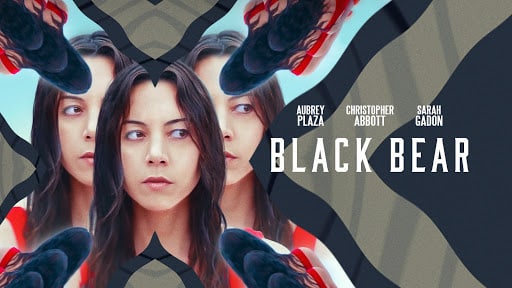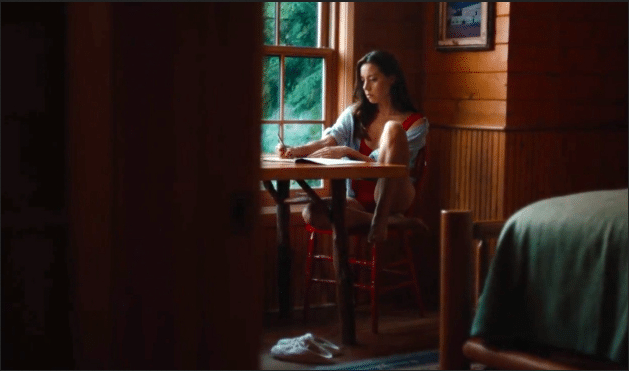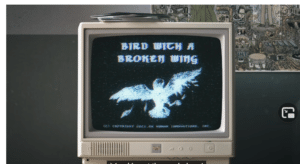
I paid the full $20 to watch the film Black Bear (online) on its release day (December 4, 2020) mostly because I’m a huge fan of lead weirdo, Aubrey Plaza. I also understood it to be a horror film of sorts, and a comedy of sorts, the combination of which promised the possibility of a metamodern sensibility. Turns out it’s a great film, a great vehicle for Aubrey Plaza, and indeed a great example of metamodern story-telling.
Aubrey Plaza seems to gravitate towards metamodern projects. Her breakthrough role was on television’s Parks and Recreation. Parks & Rec exhibits a metamodern sensibility in its exploration of how a group of diversely quirky oddballs can cohere into a larger social whole that functions with purpose and, by drawing on their very human flaws and foibles, often effectively. Aubrey Plaza’s character, April Ludgate, is a young, deadpan conceptual trouble-maker, always saying exactly the right thing to defy any expectations other people may have for what should be coming out of her mouth in any given moment. Though deeply suspicious of normal expressions of emotion (she hates hugging), and generally disruptive of others’ attempts at such expressions, somehow she manages to almost always be right on target at identifying what makes the people around her tick, on a surprisingly deep level.

The role of April Ludgate was, in fact, created specifically for Aubrey Plaza, after the show-runners had met her and experienced her doing her Aubrey Plaza thing, which they then imported directly into the Parks & Rec character. You can also see her put on this mode as a guest in dozens of talk shows and interviews. There is something truly irreducible about it. On one hand, it’s funny, but it’s also kind of unsettling in the sense that she doesn’t give her interlocutor the option of having a regular conversation – if you’re talking to Aubrey Plaza, it seems, you’re going to be participating in The Aubrey Plaza Thing. And yet, she’s so masterful in her ability to land her weirdness in just the right spot that it keeps conversational partners and audiences sticking around, waiting to see what will happen next. Or at least it keeps me around, and others who appreciate her sensibility. I imagine that talking to her feels kind of like sparring with a Kung Fu master who is capable of delivering a knockout punch to within millimeters of your face; wowing you by terrifying you yet sparing you from actually feeling a blow. But instead of a wizened old Chinese man, it’s a youthful, millennial comedian/actor keeping you just as alert. And somehow as the interaction goes along, truth and intimacy are being delivered, amidst the hijinks. In sum, there is something characteristically metamodern about the Aubrey Plaza thing, with her oscillations between disaffection and intimacy, abstraction and realness, and mild belligerence and shared delight with her audiences.
OK, back to Black Bear.
Black Bear comes in two parts, which function as separate stories – mostly. There seems to be some psychological continuity between the versions of the common characters in each part, but they’re also not the same people. Each part is set in a remote vacation cabin on a lake. Each features three characters, named Allison (Plaza), Gabe (Christopher Abbott) and Blair (Sarah Gadon). In Part One, these three are the only characters; In Part Two they are surrounded by a film crew. Both parts involve a man dividing his attention between two women, but in Part One, Gabe and Blair are the established couple with Allison as the interloper; in Part Two, it’s Blair who threatens Allison’s marriage to Gabe. These two parts are also bookended by introductory and concluding scenes in which Plaza’s character (presumably named Allison, but not necessarily), sits on a dock and then gets up to move indoors and write in a notebook. My interpretation, confirmed by watching interviews of the film’s writer/director Lawrence Michael Levine, is that the Allison in the bookends is at a cabin writing a film, and that Parts One and Two are representations of alternate drafts of the film.

The consistent theme across both parts is a focus on creative people dealing with interpersonal tensions while attempting to make art. Allison 1 is a screenwriter who has come to the cabin as a retreat, hoping to get out of a writing rut. Gabe 1 and Blair 1 are the couple who own and host the cabin, both of them artists unsatisfied with their accomplishments. Allison 2 is a fragile, talented actor starring in an indie film that Gabe 2 (her husband) is directing, with Blair 2 an actress playing “the other woman” in a scenario that recalls the story in Part One (except with the roles swapped, as I mentioned.)
Allison 1 is cut from the same mold as the familiar Aubrey Plaza persona. She keeps Gabe and Blair (and the viewer) slightly off-balance most of the time, and is seemingly the one in control (at least until things get out of control for everybody.) Vulnerabilities revealed are later shown to be lies, or… is she backing off from emotional intimacy that she’s not used to? Is she flirting aggressively with Gabe or just trying to impress Blair? The viewer is not certain, and neither are Gabe and Blair, but there is a sense that Allison has the upper hand, no matter what is really going on inside her. Like with the metamodern Aubrey Plaza persona we’ve seen elsewhere, Allison 1 keeps those around her constantly guessing what her true motives are, frustrating them while (mostly) keeping them charmed and interested, nonetheless.
The Allison in Part Two finds herself in a very different position than Allison 1. This Allison is struggling to deliver a powerful performance in the scenes being shot, while, unbeknownst to her, her husband-director Gabe and their colleague Blair are conspiring to make her think they are in an affair, purportedly in order to goad Allison into a more vulnerable state for the sake of her acting. This Allison is very much not in control, except to the extent to which she can draw upon her talent as an actor and project her most authentic self – her deep well of primal pain. And in the climactic scene she does just that: Through all the layers of film-within-a-film, alternate Allisons, people-manipulating-people, and the expectations of emotional aloofness that Aubrey Plaza brings with her from her previous roles and appearances, the actor (now referring to Allison 2 and Aubrey Plaza herself) erupts with riveting, raw passion that speaks universally to the difficulty of being human and loving other humans.

Alongside the main plot of Part Two is a secondary story that presents the viewer with a fun little send-up of what takes place behind the scenes in a stereotypical indie film production. Part One, though it doesn’t treat the actual creative process, gives a view (albeit a dramatically exaggerated one) into the lives and minds of creative people in music, dance and writing. This sense of the film being a creative project about the process of creation, along with the ambiguities rendered by its unusual structure, would lead many to understand it as postmodern film, one whose primary purpose is to ask questions about film-making itself. However, the fiery emotional core that is finally uncovered behind all of the film’s – and Aubrey Plaza’s – conceptual layers, reveals Black Bear to be a distinctly metamodern work, inasmuch as it inevitably rewards not just intellectual investment, but emotional investment, as well.
Post Script / Spoiler Section — Do not read if you haven’t seen the film.
I mentioned “horror film” and “comedy” at the beginning of this write-up. So, is it a horror film? Is it a comedy? Wikipedia calls it a “thriller” and Amazon Prime has “comedy” among the tags. In any case, I feel that the camera work, pacing and ominous score of Part One create an expectation of something gruesome and horrible just around the corner – whether supernatural or worldly. This expectation, at least for me, heightened the intensity of the painful interpersonal dynamics among the characters.
In Part Two, that horror-film tone was largely absent for me (replaced by the “horror” of a stressful film shoot), but when, in the final scene, Allison suddenly encounters the bear, it signals an affective transition in which we are left to wonder: maybe in the next scene, she would have been mauled and eaten. So, I would suggest that there is the veneer of horror painted over the film. Meanwhile, though the film is not full of moments that elicit guffaws, I can see why someone would have added the tag “comedy”: In Part One, the debates are overly drawn – they come off as a kind of parody of the creative class. And in Part Two, the depiction of a film crew’s behind-the-scenes shenanigans are definitely chuckle-worthy. This cross-genre play is another example of an aspect of the film that, taken on its own, might come across as postmodern. However, the braiding of these elements with the heart-felt vulnerability ultimately revealed in Plaza’s performance contributes to Black Bear’s metamodern affective tone.


